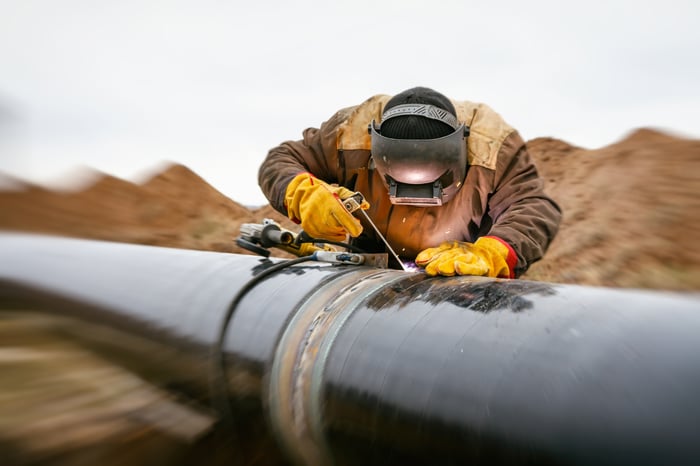There was a point in time when midstream companies were growing at a rapid clip, building the infrastructure an expanding U.S. energy industry needed. Those days appear long gone, with slow growth the norm now. Investors have punished some of the biggest midstream companies, pushing their shares well below peak levels and their yields up to attractive heights. Here's why Enterprise Products Partners (EPD 0.45%) and Enbridge (ENB -1.21%) are no-brainer stocks that dividend investors will want to consider buying today.
Big, fat, and lovely yields
There's no point burying the lead, the reason to buy Enterprise and Enbridge is their yields. Enbrige's yield is a hefty 7.3%. Master limited partnership (MLP) Enterprise's distribution yield is even higher, at 7.5%. Both have multi-decade histories of rewarding investors with regular annual increases. Enbridge's streak is up to 28 years, while Enterprise has hit 25 years.

Image source: Getty Images.
The long-term return on the stock market is something around 10%. So Enbridge and Enterprise get you about three-quarters of the way to that figure with their yields alone. And all you have to do is sit back and collect quarterly checks (or, better yet, set them up to dividend reinvest). That alone is pretty attractive. But the story here isn't over yet thanks to the regular increases in their respective disbursements. There's a caveat.
Slow growth isn't a bad thing
At one point, around a decade ago or so, pipeline companies were building rapidly in North America to support a fast-expanding onshore energy industry. That is no longer the case. Investors moving on to the next hot sector is a big part of the reason why Enterprise and Enbridge are both trading roughly 30% or so below where they were in 2014. Of course, those declines are where the attractive dividend yields come from, providing you with a head start when it comes to total returns.
The thing you need to get comfortable with is that growth today is likely to be much slower. For example, over the past five years, Enterprise's distribution has increased by about 2.5% on an annualized basis. Enbridge's dividend has grown at roughly 5% or so. Low- to mid-single digits is probably all you can expect from here on out, with increases driven by the regular price hikes, reinvestment in existing assets, and the occasional bolt-on acquisition taking place within their respective businesses.
And yet, if you add 2.5% to Enterprise's 7.5% yield you end up with 10%. If you add 5% to Enbridge's 7.3% yield you inch over 10%. Having faced a material revaluation share price-wise, it's not unreasonable to think that these midstream giants would rise in value over time at roughly the rate of their dividend growth. That's pretty attractive. And if investors start to get hip to the total return appeal, the stocks might actually rise more.
This isn't wishful thinking. In August 2008 Enterprise's yield was roughly the same as it is today. Since that point, the units' total return, which assumes the reinvestment of distributions, has beat out the total return of the S&P 500 Index (as represented here by the SPDR S&P 500 ETF). That was achieved despite the fact that the S&P 500 rose more than twice as much as Enterprise on a price-only basis. Starting with a big dividend can make a big difference.
Boring businesses and potentially exciting returns
You are unlikely to brag to anyone that you own a slow-growth pipeline company like Enterprise or Enbridge. But when you step back and look at the starting yields here, slow growth isn't a problem. In fact, slow, steady, and reliable is exactly what you should want from these two high-yielders. Living up to that modest expectation should be more than enough to produce very attractive total returns for your portfolio. Let your friends worry about chasing the hottest stock trends, while smart investors like you scoop up some boring high-yield dividend stocks.







